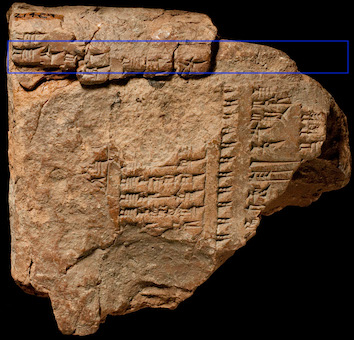Temples, Shrines, and Ziggurat of Sippar

Sippar (Sumerian Zimbir; modern Tell Abu Habbah) is the principal Babylonian cult center of the sun-god Šamaš and his wife Aya. Because this northern Babylonian city — which is located on the east bank of the Euphrates River, approximately 70 km north of Babylon — was very important and influential, its city wall Baduldua (also called Badullisâ), its principal temple Ebabbar, and its ziggurat Ekunankuga are included in first-millennium-BC lists of temples and ziggurats. In a text that enumerates religious structures hierarchically, the so-called "Babylonian Temple List," Ebabbar is ranked second, after Ekur (the temple of the god Enlil at Nippur) and before Esagil (the temple of the god Marduk at Babylon).

Obverse of K 04407 + K 21429, the "Babylonian Temple List." The name of Šamaš' temple at Sippar, Ebabbar, is mentioned in line 2 as the second highest-ranking temple in Babylonia. Image adapted from the CDLI.
Alphabetical list of temples at Sippar
- Ebabbar: temple of the god Šamaš and the goddess Aya
- E'edena: temple of the goddess Ištar as Bēlet-Sippar ("Lady of Sippar")
- Egipar: a sanctuary
- Egusisa: a sanctuary
- Ekunankuga: ziggurat of the god Šamaš
- Ekinu: temple of the goddess Aya
- Ekura: temple of the god Bunene
- Eula: temple of the goddess Gula as Ninkarrak
Construction work on Ebabbar and Ekunankuga are well attested in late Neo-Assyrian (721–612 BC) and Neo-Babylonian (625–539 BC) royal inscriptions.
Banner image: satellite image of Sipper (left); plan of Ebabbar and Ekunankuga (center); and photo from the excavations of the library at Sippar in March 1989 (right). Plan adapted from L. De Meyer Tell ed-Dēr 3: Sounding at Abū Ḥabbah (Sippar), plan B. Excavation photograph by Jean-Luc Manaud/Gamma-Rapho via Getty Images.
Jamie Novotny
Jamie Novotny, 'Temples, Shrines, and Ziggurat of Sippar', Babylonian Temples and Monumental Architecture online (BTMAo), The BTMAo Project, a sub-project of MOCCI, [http://oracc.org/btmao/Sippar/]